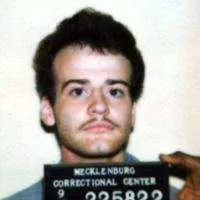Steve Roach was executed by the State of Virginia for the murder of Mary Ann Hughes
According to court documents Steve Roach would walk up to the home of seventy year old Mary Ann Hughes and when she answered the door she was immediately shot and killed. Roach who was seventeen at the time of the murder would take a few items from her home before fleeing
Steve Roach would be arrested, convicted and sentenced to death
Steve Roach would be executed by lethal injection on January 13 2000
Steve Roach Photos

Steve Roach FAQ
When Was Steve Roach Executed
Steve Roach was executed on January 13 2000
Steve Roach Case
On January 13, 2000, 23-year-old Steve Roach of Virginia was executed for killing his elderly female neighbor. Steve was just 17 at the time of the shooting—the first and only violent crime he ever committed. Attorney Steven Schneebaum and a team of lawyers at his firm, Patton Boggs, fought courageously for Steve’s life in his habeas corpus appeals to the U.S. District Court, the Fourth Circuit, the United States Supreme Court, and finally in a clemency plea to Governor James Gilmore.
Like many death row prisoners, Steve had a difficult and abusive home life as a child. Unlike many other people sentenced to death, however, he had no history of violent crime. His criminal record consisted of two counts of “joy riding” and burglarizing an unoccupied house. He was not tried as an adult for any of these offenses and had no felony convictions on his record. Remarkably, the sole aggravating factor in Steve’s capital case was “future dangerousness” based on his “four felony convictions,” which did not, in fact, exist. The factual inaccuracy and logical flaws of this reasoning did not prevent it from being relied upon by every decision maker from the Virginia Supreme Court to Governor Gilmore.
Steven Schneebaum and his colleagues at Patton Boggs went to great lengths to show that Steve was far from the “worst of the worst.” He was not a career felon, nor was he irredeemable and deserving of death. Rather, Steve was an emotionally immature 17-year-old boy from a troubled background with a handful of non-violent offenses on his record. In a single, terrible moment, he killed a friend, something entirely out of character and an act for which he accepted responsibility and expressed genuine remorse.
The courts and governor appeared to recognize these facts but were unwilling to stop the execution. Federal District Court Chief Judge Samuel Wilson stated numerous times in his opinion denying habeas relief that had he been on the jury, he would not have sentenced Steve to death. He claimed, however, that there was no legal basis for overturning the sentence. The governor’s staff met at length with Steve’s volunteer attorneys and seemed to indicate understanding of their arguments. Yet the governor ultimately denied clemency, inexplicably citing once again Steve’s “four felony convictions” and, perhaps most shockingly, claiming that “all rehabilitative efforts had failed.”
By the time of his execution, Steve had grown into a selfless young man whose last thoughts were of others. A statement released by his attorneys after the execution said in part:
Steve died without bitterness, but with a great deal of regret. He never understood what really happened in the instant in which he took the life of someone who loved him. And he was unable to grasp, even to his last breath, why we kill people to teach other people that killing people is wrong. The principal lesson he wanted his own death to communicate is that this makes no sense. Killing kids makes no sense, and it must be stopped.
Five years after Steve’s execution, the United States Supreme Court held in Roper v. Simmons that executing individuals who were under 18 at the time they committed their crimes violates the Constitution’s ban on cruel and unusual punishment. The Court’s decision followed significant national and international debate, scholarship, and legislative action, prompted by cases like Steve’s. While the Supreme Court’s decision came too late to save Steve’s life, his lawyers played a significant role in moving public opinion to the point where executing juveniles was no longer acceptable to our society.